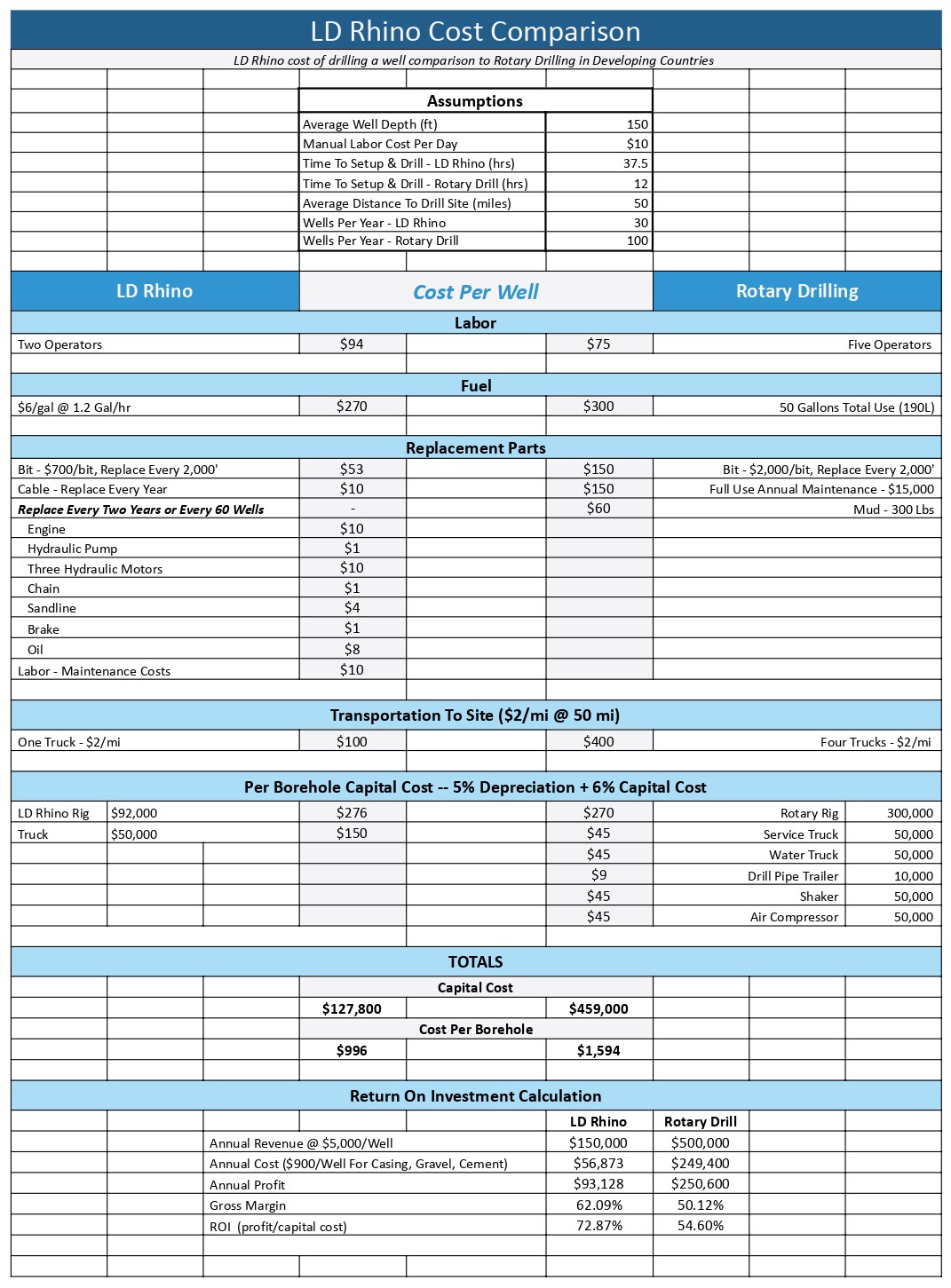Comparing LD Rhino vs. Rotary Drilling
Cost of drilling a well with LD Rhino cable tool rig compared to rotary drilling in developing countries.
Comparing Rhino vs. Rotary — Word From Our Founder
I have drilled with both small rotary rigs and our LD Rhino cable tool rig, so the comparison will be easy for me. Also I would like to add we created the LD Rhino at the suggestion of Tim Cleath, a geologist who has drilled water wells in 25 countries and who helped found the organization Lifewater International. From his vast experience he knew exactly what was lacking with the small rotary rigs. Our primary goals in designing the LD Rhino was to create a rig which was simple to operate, low cost, easy to service and maintain, with parts available throughout the world. We tested our rigs for thousands of hours with visitors from all over Africa who had little or no drilling experience drilling wells. Most, if not all learned enough in less than a week to complete a well.
Drilling with rotary rigs, the initial setup requires the construction of two mud pits. In rock this is almost impossible. In a sandy loam the pit must be constructed with an impermeable lining. Without a good lining the drilling process will require tens of thousands of liters of water due to loss of water into the formation. The pits do not do a very good job of separating the large sand and gravel as the viscosity of the mud tends to float the drilling tailings into the recirculation pond. The two ponds require lots of effort to maintain levels and the position on the pump intake hose. When the suction was too close to the bottom it would clog with tailings. When the intake was too near the top of the pond it would intake air causing the pump to loose prime. We think this is what caused the mud pump shaft seal to burn out. Without the pump drilling had to stop. Drilling would progress until we hit a rock. On one occasion we used a tricone bit in our attempt to penetrate rock but the down hole pressure was not sufficient to penetrate rock even using a 4″ bit. Ultimately the cones stopped rolling and the bit wore flat. We had to finish the well with the Rhino. Another major problem constructing wells with the small rotary rigs is that the bit tends to wander, so the hole is not straight. This causes the well casing to jam in the bore before it reaches the bottom which can cause a number of problems including stopping above the water level. Setting casing with the small rotary rigs is also made difficult because the masts are inadequate. Other drawbacks we encountered included plugging the drill stem with clay that required removing the entire drill string and cleaning out the plugged drill stem. Each 10 foot section of drill stem weighs 70 pounds so only very strong workers can manage the drill stems. Drilling with mud can also lead to missing marginal seams of water or even damaging a formation.
The LD Rhino eliminates many of the problems described above. One man can drill a well from start to finish. Setup takes just minutes. We easily drill through rock. We can easily determine when we hit water even when it is just a small amount. The auto cable feed adjusts for the proper penetration rate. The separate sandline makes bailing fast without requiring tooling change overs. We often complete drilling wells by using only one tenth of the water required for rotary drilling. We have also developed a process for keeping the bore hole from collapsing in unconsolidated formations. We accomplish this by maintaining a static level of bentonite at least 30 feet above the cave in zone. The percussion method of drilling drills very straight bores because gravity causes each impact to fall directly in line with the previous hit. Our tall 29 foot mast enables easy casing and pump installation. Our experience using carbide button bits is that they last for thousands of feet of drilling. For the nearly 100 wells I drilled with the Rhino, we would typically use a 9” bit and install 5″ PVC casing with a 2” gravel filter pack. These wells tend to last forever.


